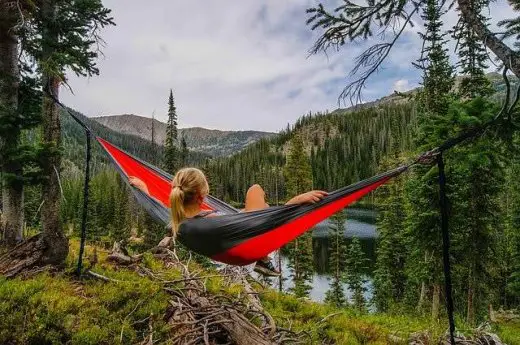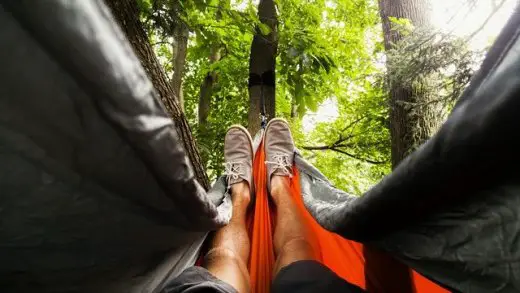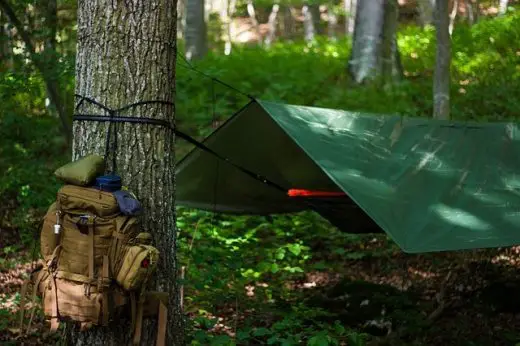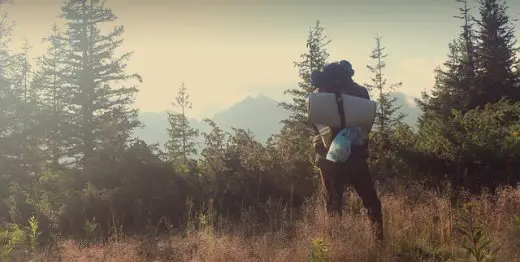
In the past few years, a new type of camping has become more popular: hammock camping. Instead of bothering with carrying and pitching a tent, hammock campers suspend a hammock between two trees and sleep on it.
While it may seem like a strange new-fangled concept, hammock camping has existed for many years. For centuries, several forest-dwelling tribes in the Amazon and Ghana have been using and still use hammocks to sleep.
Today, many modern-day campers across the world are replacing their tents with hammocks.
Why Try Hammock Camping?

Hammock camping offers many advantages compared to traditional tent camping:
- Hammocks are cheaper. Tents can be relatively expensive, and you can get a hammock for a fraction of their cost.
- Easier to set up. With the poles, pegs, nails, and other equipment, tents can be confusing and frustrating when you’re trying to set them up. Hammocks require less technique and will take less time to set up.
- More environmentally friendly. Because you aren’t using poles, hammers, and pegs to set up a tent every night, you’re not loosening soil and unintentionally harming the environment. When you set up a hammock, you use tree straps to secure it to two trees. The straps do not put too much pressure on the trees.
- You can set up anywhere. Hammocks offer much more versatility than tents; you don’t need to look for smooth, soft ground. You can tie your hammock to any trees, whether they are on a rocky surface, a canopied forest, or even next to a river!
- Hammocks are lighter and occupy less space. If you’re hiking from location to location each night, then a hammock will be more appealing as it is lighter than a tent. It will also take up less space in your hiking bag, allowing you to make room for other provisions and essentials.
- More comfortable. Many campers who have tried both hammocks and tents have found that hammocks offer them a more restful night’s sleep. This is because hammocks are more yielding and adjust themselves to match the natural curve of the body.
- You’re way above ground. Because you can zip a tent up, it offers you protection from insects and animals wandering around in the night. Hammocks protect you in a completely different way. They raise you above the ground, so you’re nowhere near any snakes, lizards, or other nocturnal creatures who are on a nighttime stroll.
- Hammock camping is more open. While traditional tents completely block you off from the elements, hammock camping allows you to look directly up into the sky and enjoy the fresh air all around you.
Despite the bounty of advantages of hammock camping, you may wonder how a hammock will protect you when there’s foul weather.
While it’s true that a tent covers you and protects you from rain, hammock camping can offer you an equal amount of protection.
Tips for Hammock Camping in the Rain

Here are a few tips to help you remain comfortable, secure, and dry when you’re hammock camping in foul weather.
Tip #1: Choose the right hammock
There are a variety of hammocks available in the market.
One of the most popular materials to make hammocks with is cotton, as it’s lightweight and allows you to stay cool as you sleep.
However, if you think you’re going to be camping in the rain, look for a hammock made from a quick-drying material like nylon or polyester.
When you are buying your hammock, also check whether it is water-resistant. To determine this, check the tags or ask someone to help you in the camping store.
You may also consider getting a double hammock. While it’s more expensive, it’s twice the size of a regular hammock and will allow you an extra layer of insulation and warmth.
This article is owned by Recapture Nature and was first published on December 19, 2019
Finally, look for a hammock with a built-in mosquito or bug net.
Anyone with experience outdoors knows that rain brings out a host of insects, including mosquitoes. Hammocks with mosquito nets will protect you from them and make sure you don’t wake up with bites and bumps.
Tip #2: Carry rain-resistant accessories
Several accessories can help make your hammock more comfortable and protect it from the rain.
Tarps
An essential accessory for rain protection is a tarp or a rain-fly.
A tarp is set up above your hammock and can provide a barrier between you and the rain.
There are four shapes of tarp: rectangular, hexagonal, catenary, and diamond. The best tarp shapes to protect you from the rain are hexagonal and rectangular, as they provide the maximum coverage.
Look for tarps made of nylon or polyester, as both of these materials are water-resistant. You can also look for rain-flys, which are tarps that are specifically designed to keep out the rain.
Your tarp should be at least ten inches longer than your hammock so that it provides adequate coverage and shelter.
Tent poles and stakes
Where there is rain, there is often wind. Tent poles and stakes will help anchor both your tarp and your hammock to make sure the wind doesn’t send your tarp or hammock flying.
I also recommend you choose lightweight poles and stakes, so the hammock’s material is not weighed down and ruined.
Strong ropes or hammock straps
You should also be sure to carry along strong ropes or – even better, hammock straps – that will help secure your hammock to the trees you choose.
Hammock straps are better as you can fasten them onto trees faster and more efficiently – that way, you’re spending less time fumbling around in the rain. But if you only have ropes, they’ll do the job just fine.
Set up your hammock correctly
Even if you have the best hammock and accessories, you can still get drenched if you don’t set up your tarp and hammock correctly.
To ensure your hammock is set up right the first time, follow these instructions:
Step 1: Make sure your tarp is easy to reach
This article is owned by Recapture Nature and was first published on December 19, 2019
When you’re packing for your camping trip, be sure to put your tarp in an easily accessible place – either at the top of your backpack or attached to it externally.
When you’re standing in the pouring rain, there will be nothing more frustrating than having all of your stuff get wet because you’re hunting at the bottom of your bag for the tarp.
Step 2: Find a suitable camping location
While hammock camping allows you to camp in a variety of different places, pay careful attention to where you choose to set up your hammock if it’s raining.
Use tree canopies to your advantage and set up your hammock by attaching it to sturdy trees with a large canopy. Ensure that your tree is secure, as rain tends to make trees weaker and more prone to falling.
When it’s raining, you may want to avoid setting up your hammock next to rivers and streams to protect yourself from the flooding that heavy rainfall may cause.
Step 3: Set up your tarp first
Logically, you should set up your tarp first. Doing so will keep your hammock and your essentials dry.
Set up your tarp so that each of the sides is at a different height – this will ensure that water flows smoothly off the tarp.
To do this, create a ridgeline – which is the rope that forms the base for the top of the tarp – that is attached at different heights to different trees. Make sure that the trees you choose are sturdy and have no dead or flimsy branches.
Once you’ve draped your tarp over the ridgeline, secure it to guylines that will anchor the tarp to the ground. When you are securing the tarp, make sure that the ropes are taut, so that water flows easily off the tarp.
Step 4: Use drip lines
Drip lines are essentially pieces of rope that are tied to your ridgelines to give water a direction to flow in. Tie drip lines or cotton shoe strings to the ridgeline under your tarp. Water running along the ridgeline will then drip down from the dripline, stopping it from reaching your hammock.
Step 5: Set up your hammock
Once you’re done establishing and waterproofing your tarp, it’s time to turn your attention to your hammock!
First, attach your hammock straps to trees, ensuring that they are at least 20 inches above the ground. Make sure to add a few knots or twists to your straps so that rainwater does not flow directly from the straps into your hammock.
Then, attach your hammock to the straps and attach some drip lines to the hammock straps to redirect the water flow.
Test your hammock to make sure it will not sag too close to the ground once you sleep on it.
Step 6: Double-check all your knots, ridgelines and drip lines
Before you sink into your hammock, do a quick check to make sure both the trap and the hammock are securely fastened. You don’t want anything to come crashing down while you’re sleeping!
You should also take a few minutes to observe how your drip lines are directing water and readjust them if necessary.
As with everything else in life, it would be helpful if you do a couple of ‘dry runs’ before heading out to camp in the rain.
Practice setting up both your tarp and hammock near home when it is lightly raining and test whether your setup is ideal for keeping you dry. If you find that there’s a flaw in your system, keep making changes until you get it right.
What Else Can You Carry to Stay Comfortable?

Equipping yourself with a tarp and the right hammock are the best ways to protect yourself from the elements. But other camping accessories will help keep you warm and dry, too.
Here are a few examples:
- A sleeping bag. While a hammock is a sort of sleeping bag itself, spreading a sleeping bag inside it and snuggling up in it will help keep you dry. Most sleeping bags are made from waterproof materials and compact easily, so they don’t add too much bulk to your camping bag.
- Sleeping pads. Place a sleeping pad at the bottom of your hammock to give you some extra protection from the dampness. Doing so will also add an extra layer of insulation, as these pads are great for trapping and retaining heat.
- Hammock underquilt. A hammock underquilt is a variation of a sleeping pad. It is designed to sit right under a hammock, creating a buffer between your hammock and the ground and acting as insulation.
- Top quilt. A top quilt works like an under quilt to insulate your hammock. But instead of being placed under your hammock, it is placed over your hammock.
- Foil blankets. If weather predictions say it’s going to be extremely cold, it’s worth bringing foil or space blankets. Foil blankets are made with special materials that reduce heat loss from the body. As the body emits heat, they capture the heat, keeping it near your body and keeping you warm. Foil blankets can be compacted easily, but tend to be fairly expensive.
- A pillow. Pillows don’t just belong on your mattress at home – you should bring them along while you’re camping. When you’re hammock camping, a pillow will make your head more comfortable and also help protect your head from the cold.
- A head torch. Don’t rely on the moon and the stars to illuminate your surroundings as you try to set up your tarp and hammock. A head torch is useful in all camping scenarios as it leaves your hands free for other tasks.
What Clothes Should You Wear?

You wouldn’t step out into the rain without wearing protective rain gear, would you? Similarly, you shouldn’t go hammock camping without donning the right clothes.
It tends to get cooler when it’s raining, so you need to look for clothes that are both warm and moisture-wicking.
Here’s a look at the different layers you need:
- Base/Inner layer. This is the layer of clothes that is closest to your body. It’s vital you choose inners made with polyester and spandex that will protect your skin from moisture.
- The insulating layer. This is the layer that will keep you warm and toasty even in the face of raging storms. Choose clothes made with fleece, wool, down, or cotton.
- Outer/shell layer. The primary function of the outer layer is to keep your other layers dry. Use plastic raincoats or jackets made from waterproof or water-resistant materials. Make sure that whatever you choose has a secure hood that will stop your head and hair from getting wet!
- Wind layer. If you’re in the middle of a rainstorm or it’s very windy, don a wind layer over your base layer. Look for clothing made from softshell fabrics. Softshell fabrics are made with softer fabrics like fleece and are tightly woven to keep out wind and water.
And here are a few more tips for hammock camping in the rain:
- Look for rain pants that you can slip over your regular pants.
- Wear rain-resistant shoes or gumboots that will prevent your socks from getting wet.
- If you’re willing to spend some extra money, buying rain gaiters which can be slipped over regular shoes or boots will help keep them dry.
- After you’re done setting up your tarp and hammock, be sure to hang up any wet clothes to dry under the tarp. That way, you’ll have some dry clothes to slip into the next morning.
Final Thoughts
There’s no better feeling than waking up dry and warm while the rain rages around you! Hammock camping allows you the best of both worlds – it allows you to breathe in the open air and enjoy the scent of wet mud and wood while staying dry and cozy.
If you’re planning on going hammock camping in the rain, be sure to practice setting up both a tarp and hammock at home. This will help you get the technicalities down, so you’ll be an expert by the time you set out into the woods.
Choose and use your hammock and hammock accessories wisely – when used right, they can each help you and your hammock stay dry.
Remember that when it’s raining, it’s likely to be cold as well, so pack both clothes and accessories that offer insulation as well as water resistance.
You may need to carry a few more essentials when hammock camping in the rain.
However, it’s worth it! You’ll enjoy night after night of pleasant, comfortable sleep and day after day of wilderness exploration.
This article is owned by Recapture Nature and was first published on December 19, 2019
If you like being exposed to the great outdoors, there’s honestly no better way to camp – even when it’s raining.

